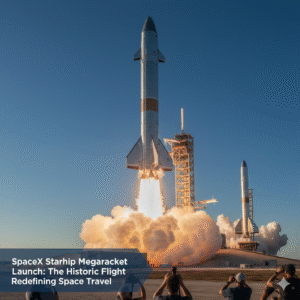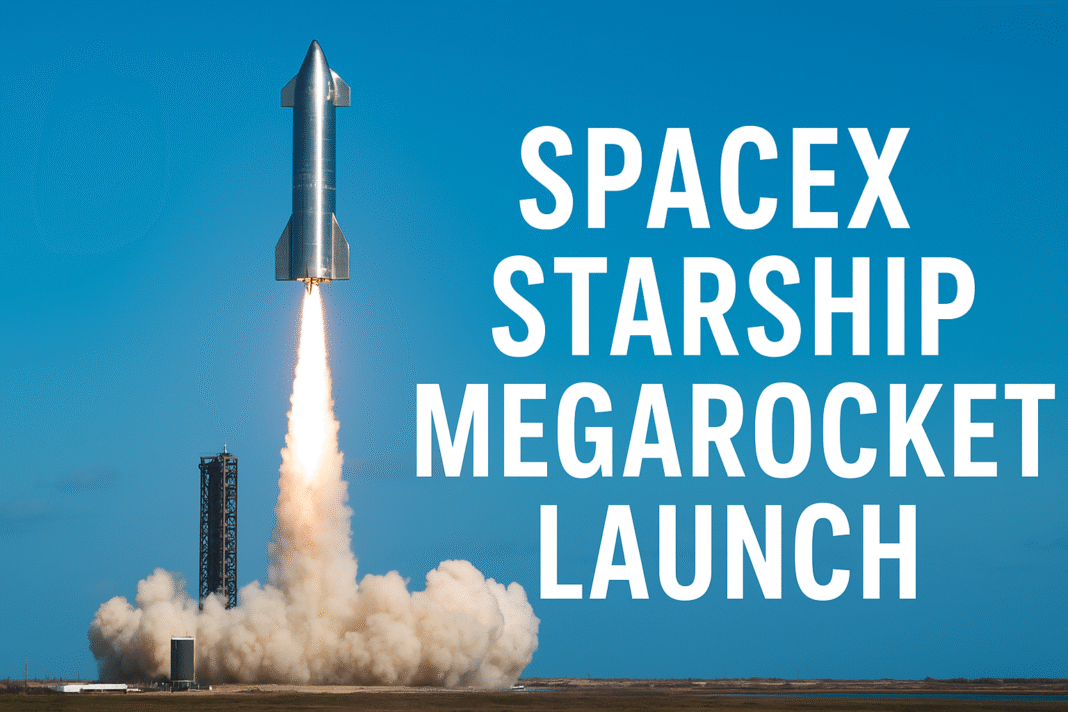Introduction

SpaceX has once again made headlines as its Starship rocket completed a successful 11th high-altitude test flight on October 13, 2025, from Boca Chica, Texas. The one-hour-long uncrewed mission demonstrated critical advancements in reusability and control, marking another major step toward Elon Musk’s vision of making humanity a multi-planetary species.
This milestone flight brings SpaceX closer to launching full-scale Moon and Mars missions, solidifying its position as the global leader in aerospace innovation.
The Flight Overview
The 11th test flight showcased both the Super Heavy booster and Starship upper stage performing precisely as planned. After liftoff, the booster separated cleanly, executed a controlled landing burn, and splashed down in the Gulf of Mexico. Meanwhile, the Starship spacecraft continued its ascent, achieving target altitude before successfully splashing down in the Indian Ocean.
This seamless choreography between stages demonstrated the core capabilities of a fully reusable launch system—a crucial step for interplanetary missions.
Major Milestones Achieved
The test wasn’t just about reaching altitude—it was about executing perfection in performance.
✅ Eight mock Starlink satellites were deployed successfully, testing Starship’s future potential as a satellite delivery vehicle.
✅ The spacecraft performed a “dynamic banking maneuver” during reentry, a complex technique to manage heat and control descent angle.
✅ Telemetry data confirmed high stability and improved heat shield endurance.
Each of these milestones plays a pivotal role in refining Starship’s readiness for human-rated missions.
Technical Highlights of the Mission
The 11th flight validated several key technologies:
-
Dynamic Banking Maneuver: Simulated a precise atmospheric entry, critical for Moon and Mars returns.
-
Raptor Engine Performance: The methane-fueled engines delivered consistent thrust and efficiency.
-
Controlled Descent: The Starship maintained orientation and balance during high-speed reentry.
This flight marked a leap in precision and reliability, key for future operational missions.
Starship’s Design and Capabilities
Starship is the most ambitious launch system ever created. Designed to carry 150 metric tons to orbit in reusable mode, it represents a quantum leap in payload capability.
-
Full Reusability: Both stages—Super Heavy and Starship—can be reused rapidly.
-
Raptor Engines: Featuring 33 engines on the booster and 6 on Starship, they use liquid methane and oxygen for high efficiency.
-
Massive Scale: At 120 meters tall, Starship dwarfs all previous rockets, including NASA’s Saturn V.
These features make Starship not just a rocket—but a transportation system for the solar system.
Comparison with Previous Flights
Earlier flights saw explosive endings and partial failures, but each one served as a data-rich learning experience.
This latest test demonstrates how SpaceX’s iterative engineering approach—test, fail, learn, improve—pays off.
From improved Raptor thrust vectoring to enhanced flight control software, SpaceX has transformed Starship from a prototype into a reliable spacecraft.
Transition from Version 2 to Version 3
This was the final flight for Starship’s Version 2 prototype. SpaceX is now moving to Version 3, a scaled-up and refined iteration featuring stronger materials, higher fuel capacity, and improved heat resistance.
Future test flights, expected in 2026, will involve Block 3 vehicles—the first capable of attempting a tower catch using SpaceX’s “Mechazilla” system.
Future Plans and the Path to Orbit
The 12th and 13th test flights will focus on orbital readiness and recovery systems. The 13th flight is expected to be the first orbital attempt, marking a historic moment in private spaceflight.
The new launch pad at Starbase is being readied to support higher launch frequencies as SpaceX ramps up production.
Starship’s Role in NASA’s Artemis Program
NASA has tapped Starship as the Human Landing System (HLS) for the Artemis Program, which aims to return astronauts to the Moon by 2027.
Starship will ferry astronauts from lunar orbit to the Moon’s surface—one of the most challenging and vital steps in the Artemis architecture.
This partnership highlights how SpaceX’s innovation supports global space exploration goals.
Mars Ambition — Musk’s Ultimate Vision
Elon Musk’s ultimate dream is clear: colonize Mars.
Starship is the vessel designed to make that dream real—capable of carrying crew, cargo, and supplies for sustained life on the Red Planet.
Uncrewed Starship missions to Mars could begin as early as 2026, delivering essential materials for future human settlement.
Economic and Technological Impact
Starship’s reusability slashes launch costs dramatically, paving the way for:
-
Cheaper satellite launches
-
Space-based manufacturing
-
Deep space tourism
-
Lunar mining operations
The ripple effects extend far beyond SpaceX—transforming global access to space for governments and private enterprises alike.
Challenges Ahead
Despite progress, challenges remain. Regulatory delays, rapid engine production, and environmental scrutiny will continue to test SpaceX’s pace.
But if history is any indication, Musk’s team thrives under pressure—and they’re already building solutions for every obstacle ahead.
What Experts Are Saying
Space analysts hail this as a “turning point in reusable rocketry.”
Aerospace consultant Laura Cheng remarked, “Each successful flight moves SpaceX closer to not just reaching Mars, but redefining how humanity interacts with space itself.”
Even NASA officials praised SpaceX’s data transparency and progress velocity—qualities rarely seen in government projects.
Conclusion
The successful 11th test flight of Starship is more than a milestone—it’s a message to the world.
SpaceX isn’t just testing rockets; it’s engineering the future of interplanetary life.
With Version 3 and orbital flights on the horizon, humanity stands on the edge of a new space era—one where traveling beyond Earth might soon become routine.
FAQs
1. What was the main goal of Starship’s 11th test flight?
To test high-altitude performance, reentry control, and partial payload deployment in preparation for orbital missions.
2. How does Starship differ from other rockets?
It’s fully reusable, more powerful than any existing launch vehicle, and capable of carrying massive payloads to the Moon and Mars.
3. When will SpaceX attempt its first orbital flight?
The 13th flight, expected in 2026, will be Starship’s first orbital mission attempt.
4. How is Starship connected to NASA’s Artemis program?
It serves as NASA’s Human Landing System (HLS), designed to land astronauts on the Moon.
5. What’s next for SpaceX’s Mars mission plans?
Uncrewed Starship missions to Mars are planned as early as 2026, paving the way for future human colonization.







